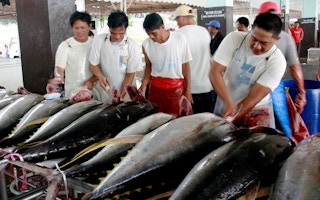The biggest consumers of tuna from the Philippine seas should invest in sustainable fisheries in the Coral Triangle region, a global hotspot of marine biodiversity surrounded by six nations, including the Philippines, the World Wide Fund for Nature (WWF) has appealed.
A series of infographics showed that fresh, chilled, frozen, and canned tuna from the Philippines are exported and potentially consumed worldwide.
Based on a data from the country’s National Statistics Office (NSO), North America, the United Kingdom, and Germany are the biggest consumers of canned tuna from the Philippines taking in more than 10,000 tons each between 2008 and 2010. They are followed by China. Canned tuna from the Philippines are exported to as many as 89 countries, leaving out only South America and parts of Africa and Central Asia. North America also leads the rest of the globe in consuming frozen and fresh or chilled Philippine tuna, followed by countries in southern Europe and again, China. “The Philippine tuna industry is struggling to meet increasing global demands, placing more pressure on fully exploited stocks in the Coral Triangle,” Dr. Jose Ingles, WWF Coral Triangle Strategy Leader, said.
According to the Western and Central Pacific Fisheries Commission Scientific Committee, some tuna species such as bigeye and yellowfin are now fully exploited. Likewise, signs of overfishing are also occurring throughout Philippine waters.
“These infographics clearly show the world’s dependence on Philippine tuna fisheries. If these large consumer countries are to continue benefiting from tuna resources from the Philippines and the rest of the Coral Triangle, more investments should be channeled towards the sustainable management of tuna in this part of the world,” Ingles added.
The Coral Triangle, encompassing the seas of the Philippines, Indonesia, Malaysia, Papua New Guinea, Solomon Islands, and Timor-Leste, is a tuna nursery where highly sought-after species such as yellowfin, bigeye, southern bluefin, and skipjack tuna migrate and spawn.
Tuna caught in the Coral Triangle makes for about 30 percent of the total global tuna catch, contributing as much as 35 percent to the total tuna catch coming from the Western and Central Pacific Ocean, which accounts for more than half the world’s tuna production.










